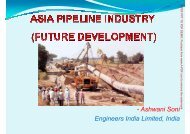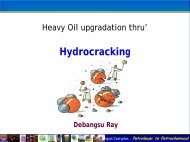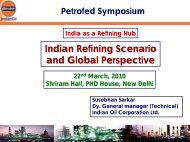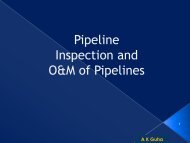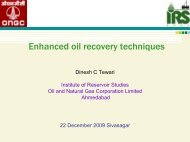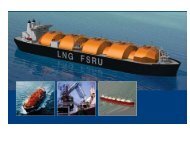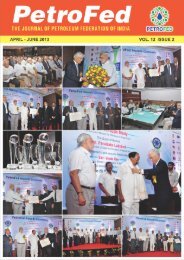presentation on delayed coker - petrofed.winwinho...
presentation on delayed coker - petrofed.winwinho...
presentation on delayed coker - petrofed.winwinho...
Create successful ePaper yourself
Turn your PDF publications into a flip-book with our unique Google optimized e-Paper software.
Presentati<strong>on</strong>OnDelayed Coking TechnologyBIRENDRA KUMAR (CTSM)BARAUNI REFINERYBarauni Refinery – In harm<strong>on</strong>y with nature
PRESENTATION ON DELAYED COKERTopics of Discussi<strong>on</strong>• Thermal Cracking•Brief Overview of Delayed Coker• Feedstock• Operating variables• Coking reacti<strong>on</strong>s• Products• Coke formati<strong>on</strong> and type of coke.• Coke Drum Cycle• Safety Hazards• Modern Delayed Coker Design FeaturesBarauni Refinery – In harm<strong>on</strong>y with nature
PRESENTATION ON DELAYED COKERThermal Cracking ProcessBarauni Refinery – In harm<strong>on</strong>y with nature
PRESENTATION ON DELAYED COKERAdvantages of Thermal Cracking•Thermal Cracking – It is simple and cost effective process. However,rapid unc<strong>on</strong>trolled thermal cracking produces undesirable products s likegas and coke.• Limitati<strong>on</strong>s of Catalytic Cracking for Resid Processing – In resid feedstock presence of high molecular weight compoundslike resins, asphaltenes and metals make it unsuitable for catalyticcracking. RFCC can process resid feed <strong>on</strong>ly upto a certain limit. Metals and sulphur compounds present in resid feedstock act ascatalyst pois<strong>on</strong>.Barauni Refinery – In harm<strong>on</strong>y with nature
PRESENTATION ON DELAYED COKERVarious Thermal Cracking Processes• VISBREAKING It is a thermal cracking process producing gas, distillates and visbroken residue(FO).• DELAYED COKING C<strong>on</strong>tinuous thermal cracking process which generates coke and produces variousdistillates in fracti<strong>on</strong>ator from vacuum residue. Coke drum temperature remainsaround 415 °C – 450 °C.• FLUID COKING C<strong>on</strong>tinuous coking process where residuum is sprayed <strong>on</strong> to fludised bed of hotcoke particles. Here cracking takes place at much higher temperature ture than <strong>delayed</strong>coking (temperature upto 565 °C).• FLEXI COKING C<strong>on</strong>tinuous coking process like Fluid Coking which includes a gasificati<strong>on</strong> secti<strong>on</strong> ofcoke produced in Fluid Coking Operati<strong>on</strong>.Am<strong>on</strong>g the above processes Delayed Coking is most popular.Barauni Refinery – In harm<strong>on</strong>y with nature
PRESENTATION ON DELAYED COKERThermal Cracking Reacti<strong>on</strong>s•Thermal cracking reacti<strong>on</strong>s take place due to applicati<strong>on</strong> of heat.During the cracking process, large molecules decompose and formsmaller (lighter) molecules.• In thermal cracking generally two types of reacti<strong>on</strong>s take place – Primary reacti<strong>on</strong>s by decompositi<strong>on</strong>s of large molecules to smallermolecules. Sec<strong>on</strong>dary reacti<strong>on</strong>s by which active products from primarycracking reacti<strong>on</strong>s further crack or react to form other molecules s orpolymerize to generate heavy products (coke).Barauni Refinery – In harm<strong>on</strong>y with nature
PRESENTATION ON DELAYED COKERThermal Cracking Reacti<strong>on</strong>s•Thermal cracking of l<strong>on</strong>g chain oil molecules into shorter chainsproceeds through a free radical mechanism -C nH2n+2 C n-2H 2n-3 + C 2H 5Initially formed free radicals readily combine with otherhydrocarb<strong>on</strong>s/free radicals/decomposed to form olefins.C 2H 5+ C nH 2n+2 C nH 2n+1 + C 2H 6C nH 2n+1 C n-1H 2n-2 + CH 3C nH 2n+1 C nH 2n + HC n-2H 2n-3 + H C n-2H 2n-2C n-2H 2n-3 C (n-2)/2n-2+ C (n(n-2)/2H n-1Barauni Refinery – In harm<strong>on</strong>y with nature
PRESENTATION ON DELAYED COKERThermal Cracking Reacti<strong>on</strong>s•Aromatics & polyneuclear aromatics undergo c<strong>on</strong>densati<strong>on</strong> reacti<strong>on</strong> withthe formati<strong>on</strong> of Asphaltenic compounds (coke forming compounds).Some typical reacti<strong>on</strong>s are –+ + H 2+ 2H 2CH 3 CH 3CH 3 CH 3+ + H 2+ 2H 2Barauni Refinery – In harm<strong>on</strong>y with nature
PRESENTATION ON DELAYED COKER• Delayed Coking is the most comm<strong>on</strong>ly used carb<strong>on</strong> rejecti<strong>on</strong> processthat upgrades residues to a wide range of lighter hydrocarb<strong>on</strong> gasesand distillates through thermal cracking.• The byproduct of <strong>delayed</strong> coking process is petroleum coke.• The goal for <strong>delayed</strong> <strong>coker</strong> operati<strong>on</strong> is to maximise the yield of cleandistillates and minimise the yield of coke.• Delayed coking technology is preferred for upgrading heavierresidues due to its inherent flexibility to handle even the heaviestresidues while producing clean liquid products.• The main products of <strong>delayed</strong> <strong>coker</strong> operati<strong>on</strong> is off-gas (from whichLPG is recovered), naphtha, Light Gas Oil (LCGO) and Heavy Gas Oil O(HCGO). LCGO is sent to Hydrotreater for producti<strong>on</strong> of Gas Oil andHCGO to refinery FO Pool/ RFCC feedstock/ OHCU feedstock.Barauni Refinery – In harm<strong>on</strong>y with nature
PRESENTATION ON DELAYED COKER• The yield slate for a Delayed Coker can be varied to meet a refinerner’s s objectivethrough the selecti<strong>on</strong> of operating parameters.• Three operating parameters govern the yield pattern and product quality ofDelayed Coker –‣ Temperature‣ Pressure‣ Recycle Ratio (RR)• Increasing coking temperature decreases coke producti<strong>on</strong> and increases liquidyield and gas oil endpoint. However, temperature can be adjusted d <strong>on</strong>ly anarrow range to c<strong>on</strong>trol volatilities left in coke.• Increasing pressure and/or Recycle Ratio (RR) increases gas and coke makeand decreases liquid yield and gas oil endpoint. RR can be varied d from 0% to120%.• Recycle Ratio is defined as –(Composite feed to Coker Heater)/ (Primary feed to Fracti<strong>on</strong>ator bottom)Barauni Refinery – In harm<strong>on</strong>y with nature
PRESENTATION ON DELAYED COKER• Modern trend of Delayed Coking technology is to minimise the cokingpressure and recycle ratio within the ec<strong>on</strong>omic and technicalc<strong>on</strong>straints for designing a unit while producing clean Heavy CokerGas Oil (HCGO) product within following quality – Low c<strong>on</strong>taminant level of carb<strong>on</strong> residue.Low c<strong>on</strong>taminant level of metal. End point within acceptable level.• Delayed Coker products typically require further downstreamhydroprocessing because of hydrogen deficiency and sulphurc<strong>on</strong>taminati<strong>on</strong>.• Fuel grade coke is a low value byproduct. However it has significantdemand as a clean and ec<strong>on</strong>omic fuel.Barauni Refinery – In harm<strong>on</strong>y with nature
PRESENTATION ON DELAYED COKERDelayed Coking Feedstock –• Delayed Coker can process a wide variety of feedstocks :-‣ Feedstock can have c<strong>on</strong>siderable amount of metal (Ni + V), Sulphur,Resins and Asphaltenes.‣ C<strong>on</strong>taminants present in feedstock mostly gets eliminated with coke. c•Most typical feedstock is Vacuum Residue (530 °C C +). It can also processrefinery slop oil/ sludge.• Atmospheric residue is also occasi<strong>on</strong>ally processed.• Typical feed compositi<strong>on</strong> –‣ Sulphur – 5 to 6 % wt‣ Metals 1000 ppmw.‣ CCR – 20 TO 30 % wt.• Properties of coke mostly depends <strong>on</strong> feed quality.Barauni Refinery – In harm<strong>on</strong>y with nature
PRESENTATION ON DELAYED COKERDelayed Coking ProcessBarauni Refinery – In harm<strong>on</strong>y with nature
PRESENTATION ON DELAYED COKERChemical Reacti<strong>on</strong>s of Carb<strong>on</strong>izati<strong>on</strong> –•There are three types of chemical reacti<strong>on</strong> processes which occur c<strong>on</strong>tinuouslywithout any distinct steps in the coking process –‣ Dehydrogenati<strong>on</strong> – The initial reacti<strong>on</strong> in carb<strong>on</strong>izati<strong>on</strong> involves the lossof hydrogen atom from an aromatic hydrocarb<strong>on</strong> and formati<strong>on</strong> ofaromatic free radical intermediate.‣ Rearrangement Reacti<strong>on</strong>s – Thermal rearrangement usually leads toformati<strong>on</strong> of more stabilised aromatic ring system which forms buildingblock of graphite growth.‣ Polymerisati<strong>on</strong>of aromatic radicals – Aromatic free radicals getpolymerised in the process of coking reacti<strong>on</strong>. This process is initiated inthe liquid phase and c<strong>on</strong>tinued in different steps.Barauni Refinery – In harm<strong>on</strong>y with nature
PRESENTATION ON DELAYED COKERREACTOR485 O C420 O C485 O CREACTORLDO / SLOPQUENCHBFWBFWQUENCHCOL nFLUE GAS410 O CMP STEAMBFWRFOMPSTEAMBFW240 O C115 O CMAINFRACTIONATOR200 O C330 O C280 O CMPSTEAMBFW1.8 kg/cm 2 g45 O C405 O C 45 O C95 O CIRFO IRCRSOUR WATERNAPHTHA45 O CLCGO - IMP STEAMLCGO - IIBFWMP STEAM95 O CBFWOFFGASFRESH FEEDHCGOFURNACE340 O C340 O CPETROCOKE502 O CBOTTOM PUMPBOTTOM PUMPDCU FLOW DIAGRAMBarauni Refinery – In harm<strong>on</strong>y with nature
PRESENTATION ON DELAYED COKERTypical Drum Cycle Time –Drum CycleHoursSteam to Fracti<strong>on</strong>ator 0.5Steam to Blowdown 1.5Low range cooling & water quench 4.5Depressurisati<strong>on</strong> & Drain 2.0Unheading top and bottom cover 1.0Coke Cutting 3.0Reheading/ steam testing/ purge 1.0Drum warm-up/ Vapour heating 4.0Change-over / Drum Switch 0.5Total 18.0Barauni Refinery – In harm<strong>on</strong>y with nature
PRESENTATION ON DELAYED COKERCYCLIC PROCESS OFDELAYED COKINGLITTLE STEAMBIG STEAMLITTLE WATERBIG WATERWATER DRAINCOKING CYCLEOF A COKE DRUMDECOKING CYCLEOF A COKE DRUMCOKINGCOKE DRUM PREHEATCOKE DRUM STEAM PR. TESTCOKE DRUM STEAM PURGECOKE DRUMUNHEADINGHYDRAULICDECOKINGCOKE DRUMHEADINGBarauni Refinery – In harm<strong>on</strong>y with nature
PRESENTATION ON DELAYED COKERCoke Drum Warm-upup–•To prepare the empty coke drum for receiving feedstock ex process s heater, hotvapors from <strong>on</strong>line drum are circulated into the empty drum for preheating pof cokedrum.•The hot vapours (at around 415 °C) c<strong>on</strong>denses inside the cold vapour drum,heating the drum to a target temperature of around 340 °C.•C<strong>on</strong>denservapours are c<strong>on</strong>tinuously drained out of the drum initially through theblowdown circuit and later to main fracti<strong>on</strong>ator.•Aftervapour heating the drum for few hours, hot oil (RCO/ VR) ex furnace (ataround 485 °C) is switched to drum.•Most of the vapour c<strong>on</strong>denses <strong>on</strong> the colder wall of the drum , liquid remaining asboiling pool of oil at the bottom.Barauni Refinery – In harm<strong>on</strong>y with nature
PRESENTATION ON DELAYED COKERSteam Stripping –•Steam must be flowing before the switch and immediately after the e switch andimmediately after the switch otherwise the neat unc<strong>on</strong>verted feedstock <strong>on</strong> thetop of coke bead will run down the channels which will solidify and plug thechannels.•This will lead to isolati<strong>on</strong> / plugging of the coked porti<strong>on</strong> from steam andcooling water resulting in formati<strong>on</strong> of hot spots.•These hot spots may result in dangerous steam erupti<strong>on</strong> during cutting of cokewhich is a potential safety hazard.•Steam stripping also serves to transfer heat from the hot bottom porti<strong>on</strong> of thecoke bed to unc<strong>on</strong>verted liquid present at the top of the coke drum.•Adequate steam stripping increases the quantity of recovered gas oil as well asreduce the amount of volatile matter present in the bottom secti<strong>on</strong> of the cokedrum.Barauni Refinery – In harm<strong>on</strong>y with nature
PRESENTATION ON DELAYED COKERDelayed Coking ProductsBarauni Refinery – In harm<strong>on</strong>y with nature
PRESENTATION ON DELAYED COKERProducts of Delayed Coking –•Delayed<strong>coker</strong> produces desirable liquid products (naphtha and gasoil) and byproducts <strong>coker</strong> gas and solid coke.•Coker off-gas goes to the gas plant where C3 and C4 is recovered asLPG and the lighter end can be used as fuel gas in the refinery.•Naphtha ex <strong>coker</strong> unit c<strong>on</strong>tains high olefin c<strong>on</strong>tent and this stream isusually sent to hydrotreater for stabilisati<strong>on</strong>.•Light Coker Gas Oil (LCGO) is sent to diesel hydrotreaterforproducti<strong>on</strong> of diesel. Typical end point of this stream is around 370 °C.•Heavy Coker Gas Oil (HCGO) is sent to FCC/ RFCC for producti<strong>on</strong> of ovaluable distillate products. Typical end point of this stream is around538 °C.Barauni Refinery – In harm<strong>on</strong>y with nature
PRESENTATION ON DELAYED COKERTypical Yield Pattern of Delayed Coking –PARTICULARS PR BRFeed Quality :-Feed CCR, % wt 22 11Feed “S”, % wt 4.8 1.2Yield Pattern (% wt) : -Gas + H 2S 5.0 8.0LPG 3.0 4.0Light Naphtha 6.0 8.0Heavy Naphtha 5.0 -LCGO 32.0 40HCGO 19.0 15Coke 30.0 25Barauni Refinery – In harm<strong>on</strong>y with nature
PRESENTATION ON DELAYED COKERType of Coke –Coke formed in Delayed Coker Unit can be classified into threedifferent types–‣Sp<strong>on</strong>ge Coke‣Needle Coke‣Shot CokeBarauni Refinery – In harm<strong>on</strong>y with nature
PRESENTATION ON DELAYED COKERSp<strong>on</strong>ge Coke –• Sp<strong>on</strong>ge Coke is porous, irregular shaped lumps.•It was named by its sp<strong>on</strong>ge like appearance.•Vacuum Residue with low to moderate asphaltene produces sp<strong>on</strong>gecoke.• Most of the sp<strong>on</strong>ge coke is used as fuel.•Some sp<strong>on</strong>ge coke with low sulphur (< 2% wt) and metal c<strong>on</strong>tent canbe used to make anodes used in aluminium industries.Barauni Refinery – In harm<strong>on</strong>y with nature
PRESENTATION ON DELAYED COKERBarauni Refinery – In harm<strong>on</strong>y with nature
PRESENTATION ON DELAYED COKERNeedle Coke –•It is a premium coke from Delayed Coker named by its needle likeappearance.•Feedstock with aromatic comp<strong>on</strong>ent (without much asphaltene) ) helpsto produce needle coke. FCCU decant oil after hydrodesulphurisati<strong>on</strong> forremoval of sulphur used as needle coke feedstock.• It has microscopic, el<strong>on</strong>gated, needle like structure.•It has very low coefficient of thermal expansi<strong>on</strong> (CTE) and electricalresistance suitable for using as electrodes in steel making.Barauni Refinery – In harm<strong>on</strong>y with nature
PRESENTATION ON DELAYED COKERBarauni Refinery – In harm<strong>on</strong>y with nature
PRESENTATION ON DELAYED COKERShot Coke –•It is formed from high asphaltene c<strong>on</strong>tent feedstock present at highcoke drum temperature.• Shot coke is undesirable product in <strong>delayed</strong> coking.•With the light ends flashing-off small globules of tar are formed whichrapidly c<strong>on</strong>verted to coke due to huge heat generati<strong>on</strong> duringexothermic asphaltene polymerisati<strong>on</strong> reacti<strong>on</strong>.• Shot coke is usually blended with sp<strong>on</strong>ge coke to use as fuel.Barauni Refinery – In harm<strong>on</strong>y with nature
PRESENTATION ON DELAYED COKERBarauni Refinery – In harm<strong>on</strong>y with nature
PRESENTATION ON DELAYED COKERComparis<strong>on</strong> of Different Types of Coke –Sp<strong>on</strong>ge Coke Needle Coke Shot Coke• Porous, irregularshaped.• Feed – Moderateasphaltene level.• High “S” – FuelGrade.• Low “S” – AnodeGrade.• Needle likestructure.• Feed – Low “S”,verylowasphaltene witharomaticcomp<strong>on</strong>ent.• Premium GradeCoke.• Very low CTE.• Undesirable.•Feed – HighAsphaltene.•Difficult andunsafe to handle.Barauni Refinery – In harm<strong>on</strong>y with nature
PRESENTATION ON DELAYED COKERThumb Rule for Yield Predicti<strong>on</strong> –• Coke and liquid yields can be predicted by simple equati<strong>on</strong>a as under -• Coke Yield (wt%) = 1.6 X (wt% feed CCR)• Gas (C4 - ), wt% = 7.8 + 0.144 X (wt% feed CCR)• Gasoline (wt%) = 11.29 + 0.343 X (wt% feed CCR)• Gas Oil (wt%) = 100 – wt % coke – wt % gas – wt % GasolineBarauni Refinery – In harm<strong>on</strong>y with nature
PRESENTATION ON DELAYED COKEREffect of Operating VariablesBarauni Refinery – In harm<strong>on</strong>y with nature
PRESENTATION ON DELAYED COKEREffect Of Coke Drum Temperature –•At c<strong>on</strong>stant pressure and recycle ratio, the coke yield decreases anddistillate yield increases as drum temperature increases.•If the temperature is too low, the coking reacti<strong>on</strong> does not proceed farenough and pitch and soft coke formati<strong>on</strong> occurs.•When the temperature is too high the coke formed generally is veryhard and difficult to remove from the coke drum with hydraulicdecoking equipment.•The temperature is used to c<strong>on</strong>trol the Volatile Combustible Matter(VCM) of coke. At higher temperature VCM is reduced.Barauni Refinery – In harm<strong>on</strong>y with nature
PRESENTATION ON DELAYED COKEREffect Of Coke Drum Pressure –•Coke yield decreases by reducing coke drum pressure. Every 0.5kg/cm2 reducti<strong>on</strong> in coke drum pressure increases liquid yield by 1.3%vol and reduces coke yield by 1 % wt of fresh resid feed.•For producing premium grade coke, coke drum should operate athigher pressure. Raising the pressure suppresses vaporisati<strong>on</strong> of gas oilin the coke drum. It extends the retenti<strong>on</strong> time of aromatic compoundsoundswhich favours the formati<strong>on</strong> of better quality coke.•Higher pressure improves the coke quality w.r.t lowering of Co-efficient of Thermal Expansi<strong>on</strong> (CTE) and electrical resistivity.Barauni Refinery – In harm<strong>on</strong>y with nature
PRESENTATION ON DELAYED COKEREffect Of Recycle Ratio (RR)–•Increase in Recycle Ratio (RR) increases coke make and improves cokeproperties.•Increase in Recycle Ratio lowers the combined feed resin asphaltene c<strong>on</strong>tentand in turn also provides a higher c<strong>on</strong>centrati<strong>on</strong> of aromatics in coke drums.•High RR – Results in more coke, more gas & gasoline, less distillate, lessdepositi<strong>on</strong> of coke in heater tubes.•Low RR – Results in less coke, less gas & gasoline, more distillate, moredepositi<strong>on</strong> of coke in heater tubes.•HCGO quality deteriorates at lower RR w.r.t its density, CCR, metal c<strong>on</strong>tent,end point etc.•ModernCokers operate at 10% or less RR to increase unit throughput.Barauni Refinery – In harm<strong>on</strong>y with nature
PRESENTATION ON DELAYED COKEREffect Of BFW Injecti<strong>on</strong> in Heater Coils –• Used as a turbulising water in heater coils.• Reduces partial pressure of hydrocarb<strong>on</strong> in the coke drum.• Leads to formati<strong>on</strong> of loose coke.•Normallyturbulising water is kept @ 1% of pass flow. However, itdepends <strong>on</strong> heater design.Barauni Refinery – In harm<strong>on</strong>y with nature
PRESENTATION ON DELAYED COKERSummary of Impact of Operating Parameters –Increasing Gas Yield C5 + LiquidYieldPressureRecycle RateCoil TemperatureVelocity MediumCoke YieldHCGOQualityImprovesImprovesDeterioratesDeterioratesBarauni Refinery – In harm<strong>on</strong>y with nature
PRESENTATION ON DELAYED COKERProcess Licensors of Delayed Coker –Some of the well known process licensors of Delayed Coker Unitare as under–‣ Foster Wheeler‣ Lummus Technology‣ C<strong>on</strong><strong>on</strong>o Philips‣ Exx<strong>on</strong> Mobil etc.Barauni Refinery – In harm<strong>on</strong>y with nature
PRESENTATION ON DELAYED COKERSafety Hazards & Mitigati<strong>on</strong>Barauni Refinery – In harm<strong>on</strong>y with nature
PRESENTATION ON DELAYED COKERDelayed Cokers – Safety Hazards :–:• Coke drum switching –‣ Severe accidents reported due to faulty valve operati<strong>on</strong> duringcoke drum switching operati<strong>on</strong>.• Coke drum head removal –‣ Hot erupti<strong>on</strong>s due to inadequate coke bed cooling.‣ Incomplete draining before bottom head removal.‣ Avalanche of shot coke during bottom head removal.• Coke cutting operati<strong>on</strong>s –‣ Cutting tool raised out of coke drum without isolati<strong>on</strong>.‣ Bursting of water hose.‣ Failure of wire rope supporting the drill stem.• Others –‣ Dust irritati<strong>on</strong>, toxic exposure, coke handling by o/h cranes,c<strong>on</strong>veyors, crushers pay loaders etc.Barauni Refinery – In harm<strong>on</strong>y with nature
PRESENTATION ON DELAYED COKERDelayed Cokers – Mitigati<strong>on</strong> of Safety Hazards :–:• Coke drum switching –‣ Remote operated system for removing faulty operati<strong>on</strong>.‣Colourcoding of valves to avoid faulty operati<strong>on</strong>.‣ Employees working in pair – “buddy system”• Coke drum head removal –‣Remote opening/ closing of coke drum head.‣Restricted movement of people <strong>on</strong> coke drum top and bottomplatforms.• Coke cutting operati<strong>on</strong>s –‣Interlocks to prevent drill stem to come out of the coke drum w/oisolati<strong>on</strong>.‣Remote switch off for jet pump.Barauni Refinery – In harm<strong>on</strong>y with nature
PRESENTATION ON DELAYED COKERModern Delayed CokersDesign FeaturesBarauni Refinery – In harm<strong>on</strong>y with nature
PRESENTATION ON DELAYED COKERModern Trend in Delayed Coker Technology –• Maximize the producti<strong>on</strong> of liquid distillate.• Minimize the producti<strong>on</strong> of coke.• Produce heavy gas oil suitable for downstream catalytic processing.• Optimize number and size of coke drums.• Optimize energy recovery.• Optimize feed pre-heat system and heater duty.• Maximize air cooling and minimize water cooling.• Low pressure operati<strong>on</strong> i.e 1.05 kg/cm2-g g drum pressure.•Reducti<strong>on</strong> in Recycle Ratio (10% or lower) for maximizing distillateyield.• High CCR feed processing.Barauni Refinery – In harm<strong>on</strong>y with nature
PRESENTATION ON DELAYED COKERModern Trend in Delayed Coker Technology –• Shorter coke drum cycle (18 hours or lower).• No sloping from blowdown.•Refinery slop (with reactor o/h quench) and sludge (during coke drumquench) processing.•Increased heater run length ( 1 Yr +) and <strong>on</strong>line spalling.• No quench column/ RFO generati<strong>on</strong>.• Double fired heater with <strong>on</strong>line spalling and decoking facility.• Automatic heading and deheading system.• Hydrocycl<strong>on</strong>e for recovery of coke cutting water.Barauni Refinery – In harm<strong>on</strong>y with nature
PRESENTATION ON DELAYED COKERIn NUTSHELL –Delayed Coking is an attractive opti<strong>on</strong> for upgradati<strong>on</strong> ofresidual fracti<strong>on</strong>s.Coking is a severe thermal cracking process aimed at distillateand lighter producti<strong>on</strong> during which coke is also formed.Modern trend is to go for low recycle, low pressure DelayedCokers for maximizing liquid yield.Barauni Refinery – In harm<strong>on</strong>y with nature
PRESENTATION ON DELAYED COKERTHANK YOUBarauni Refinery – In harm<strong>on</strong>y with nature




